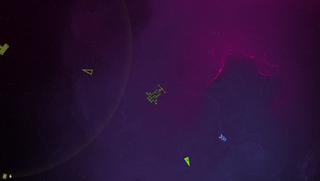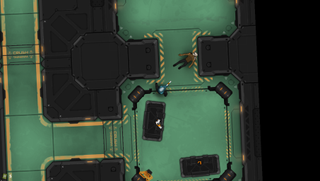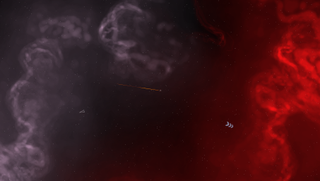

Samuel and Tim got a chance to play an early build of Heat Signature at this year's GDC.
Samuel Roberts, Editor
Tim Clark, Global Editor-in-chief
Samuel Roberts: The last time I saw Heat Signature, Tom Francis’s impressive procedurally-generated space heist game, I just about got to grips with its simple mission structure. Players dock their pod on these little green chambers floating through space, receive an objective, then go off to try and land on a larger enemy ship to perform some kind of criminal activity: usually collecting something illegally. The cycle then begins again. Each ship is randomly generated, so you never know exactly what you’re facing when you dock. You can steal these bigger ships, too, and pilot them through the galaxy. It’s like a 2D space sandbox to some extent.
This time, I had more of a feeling for the combat, which isn't a million miles away from Hotline Miami in being top down, mouse-controlled with a basic melee attack and weapons to collect. It’s a bit tricky to get at first, but the arc of receiving your next target, swiftly docking with a ship, knocking someone out, stealing something then silently blasting off into space feels really strong. Of course, I’m saying that like me or you pulled all that off without a hitch, which is just blatantly untrue, Tim. It took us both a while to understand exactly how Heat Signature works. A lot of hilarious failure with intermittent success.
Tim Clark: I knew from the get-go that my sausage fingers were going to betray me when it came to lining up the little pod with target airlocks. Despite the fact it’s actually pretty forgiving in terms of the collision detection, I felt a terrible sense of performance anxiety as I clanged off hull after hull. It was a bit like failing an interstellar driving test, only with the creator of the entire universe holding the clipboard. However, once I got used to dabbing the thrusters a bit more conservatively, the get-mission/board-ship loop which Sam mentions began felt very moreish.
Heat Signature being a resolutely systems-driven game, the really fun stuff often happens with little warning. During one mission, I’d barely stepped inside the ship I was meant to be hijacking when it came under fierce attack from another vessel. There was no time to parse what was going on before the hull had been cracked open and the crew had been sucked out to meet the chilly kiss of the void. Luckily, (relatively speaking), I hadn't been shot by any of the guards, so I wasn't bleeding out—but I was alone and adrift. Essentially the movie Gravity, but recreated with a few dozen pixels.
Hitting tab enables you to switch back to controlling your pod, then zoom back to collect yourself. I got pretty good at this part, because whenever you’re shot whilst boarding, the guard who did the deed will carry your body to the airlock and toss it out like a bin bag. In space, no one can hear you complain about recycling properly.

Samuel: The ship coming under attack with you inside and subsequent recreation of Gravity was actually hilarious, Tim. It underlined how fun the elements of Heat Signature are when thrown together like that. Nothing even close to it happened in the rest of what was a pretty short demo, which bodes well for the chances of amusing, random chaos kicking off during ordinary missions in the finished game.
With the variety of your arsenal, too, there’s room for experimentation in blowing things up. Detonation charges can blow spaceships in half when placed properly, and with a bunch of them in my inventory, I enjoyed irresponsibly planting them and then watching everything in the ship (including myself) get sucked out into the atmosphere. That sort of player-generated fun has a lot of mileage to me. You could fire a gun and attract a group of enemies, then detonate a room with them all inside to send them tumbling into space. I was a cowardly Hotline Miami player who constantly lured out groups of enemies with gunshots before beating them to death. This sort of tactic therefore appeals to me.
PC Gamer Newsletter
Sign up to get the best content of the week, and great gaming deals, as picked by the editors.

Click the arrows to enlarge.
A concept image showing possible different styles for random ship generation.
I’m wondering how you found the combat, Tim. Basic melee attacks charge in a line, and you really don’t have much of a chance when facing the enemy head-on. This is, in every sense, a stealth game.
Tim: Well, the disclaimer here is that I haven’t sunk the insane amount of hours into Hotline Miami that you have. So, you took to smashing the guards’ skulls in with a wrench like a duck to a bloodbath. Meanwhile, I soon realised that I was going to have to lean heavily on stealth over combat to get any sort of piracy business done. I liked the fact that once onboard you can loiter in the airlock for a couple of seconds, while sketching out your plan for how to get to the objective.
One thing I’m keen to learn more about is how the reward system will work. You can find ship upgrades, like improved coolant to help evade those pesky heat detectors, and additional detonation packs for blowing sections of ships away, but I’d be keen to be able to find some more substantial rewards, either at random or for tackling really tricky missions. I guess there’s a tension with replayability here, and not wanting players to feel punished for losing their stuff, because Tom suggests he expect the average life in Heat Signature to not last hugely long. So that maybe renders significant loot rewards pointless if you’re going to be dead before you’ve had much of a chance to use them. Do you think the structure seems compelling for long-term play?

Samuel: I think that those short lifespans actually make the upgrades seem more precious. Enjoy them, because they’ll soon be gone! Tom teased other elements that’ll encourage long-time play as well, which hold promise for the longer-term structure of Heat Signature. They’re not in the game yet, but he wants to include a series of characters who you randomly encounter and unlock, who then have individual one-off missions, sort of like short stories within the galaxy that flesh out the fiction. He cited a revenge tale as an example, so that to me indicates that he’s thinking ahead to what the player will be doing maybe five or six hours in. These instances would not be repeatable, which will make them feel special when they do happen.
Tim: Yeah, that stuff did sound interesting—and, contradicting myself here, I like the idea that if you balls up one of those missions then it’s just gone for that playthrough. I’m also keen to see how the different factions pan out. Tom seems committed to keeping them all human, but with different themes like industrial miners or junkers who cobble their ships together from salvage. He certainly didn't seem sold on the idea of aliens or robots, though the artist who’s coming up with different ship designs has been making a case for them on the basis of the cool ship looks he’s come up with.
Samuel: I like the idea of robots and aliens too, because I’m an enormous child, but I also like that Francis is treating it as a serious sci-fi universe. Spaceships and stealing things. What’s not to love?
Disclosure: Tom Francis is a former staff member of PC Gamer, though he never worked directly with either Sam or Tim. While Sam has been in the same pub as Tom a couple of times in the past year, they’ve both made it very clear that they don’t like each other. You can sign up to potentially be a Heat Signature tester here.
Hey folks, beloved mascot Coconut Monkey here representing the collective PC Gamer editorial team, who worked together to write this article! PC Gamer is the global authority on PC games—starting in 1993 with the magazine, and then in 2010 with this website you're currently reading. We have writers across the US, UK and Australia, who you can read about here.
Most Popular



